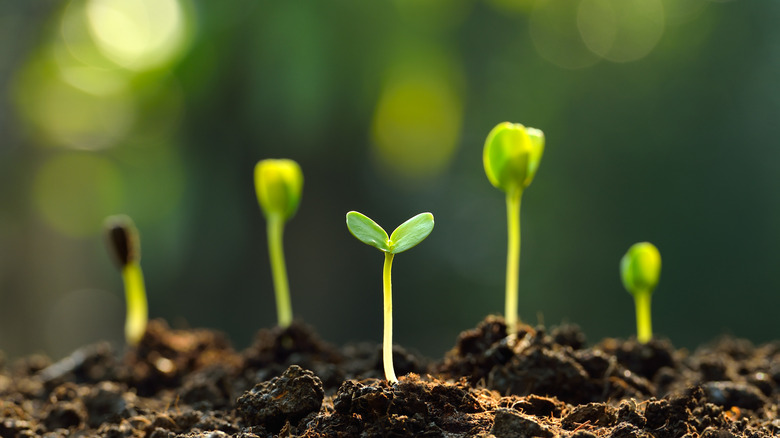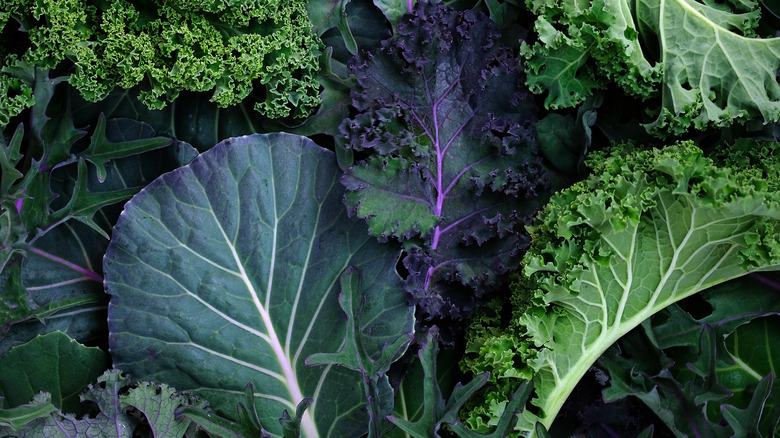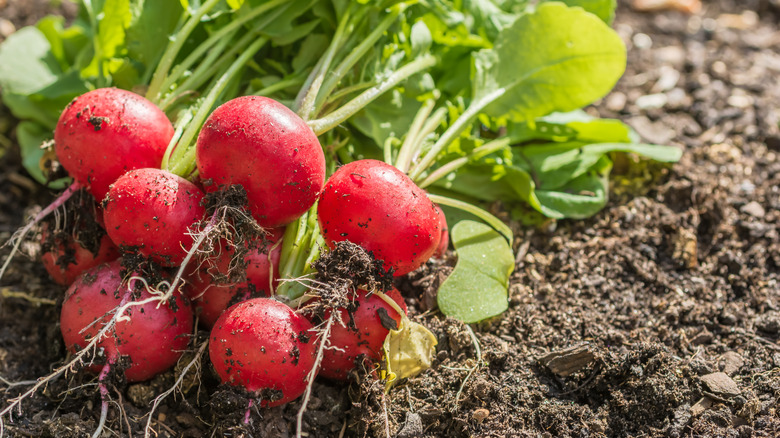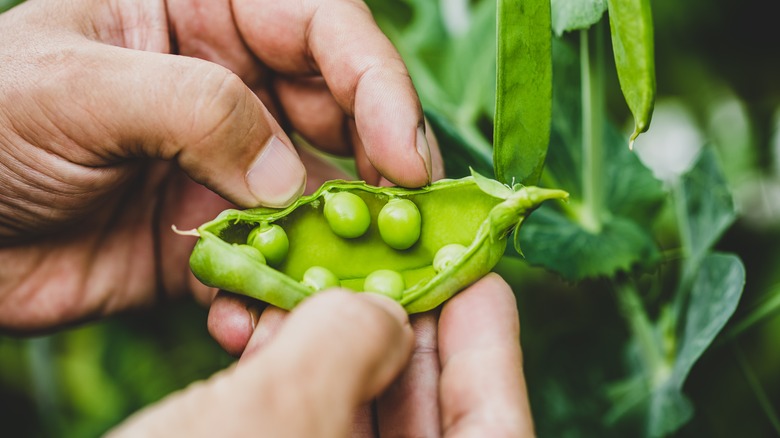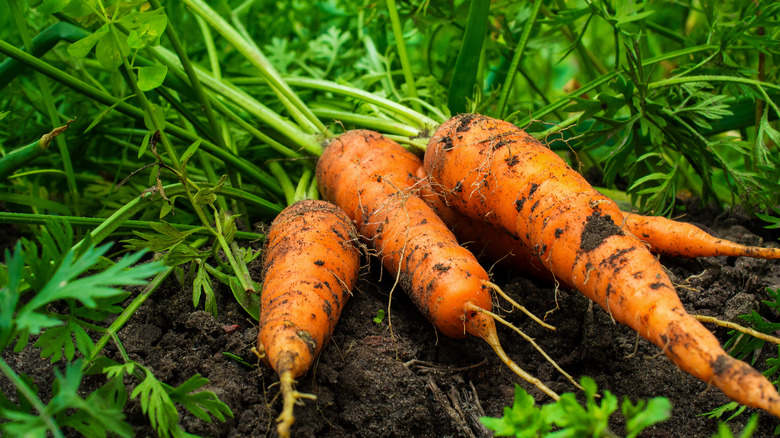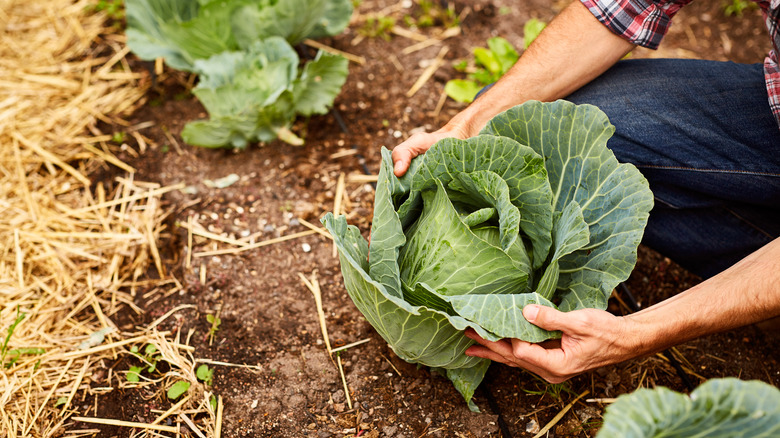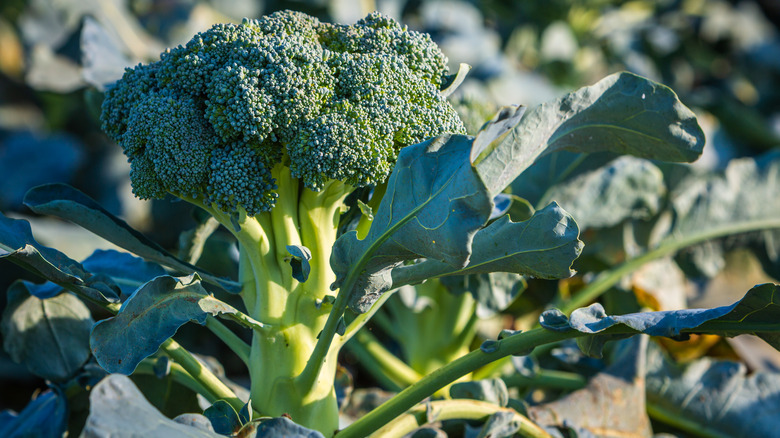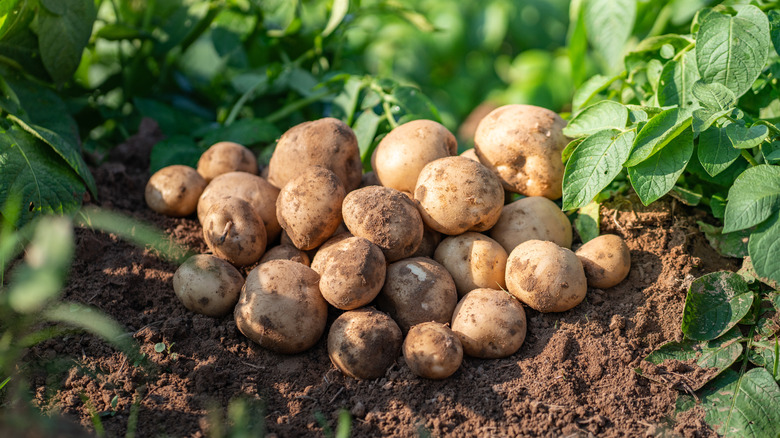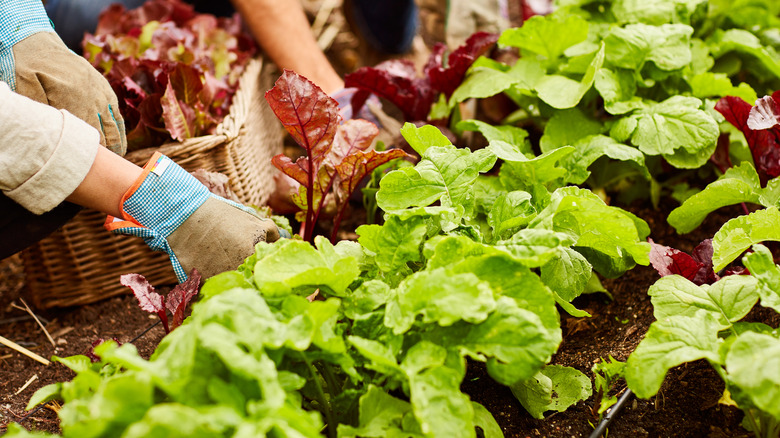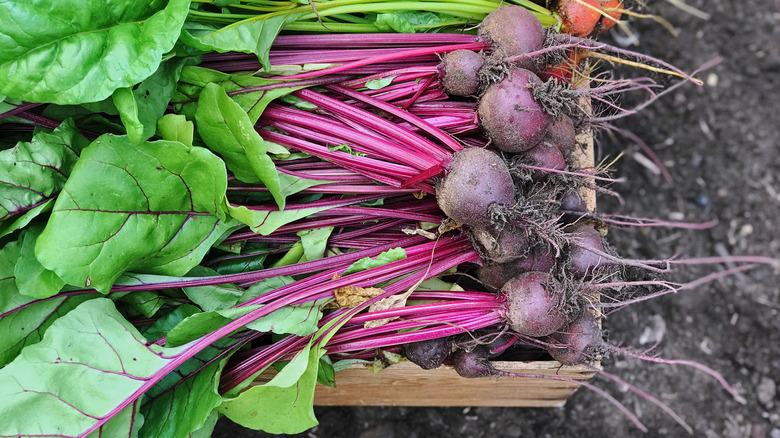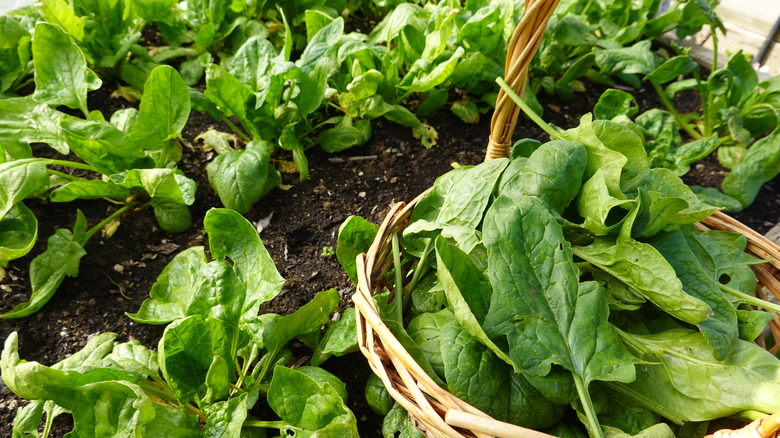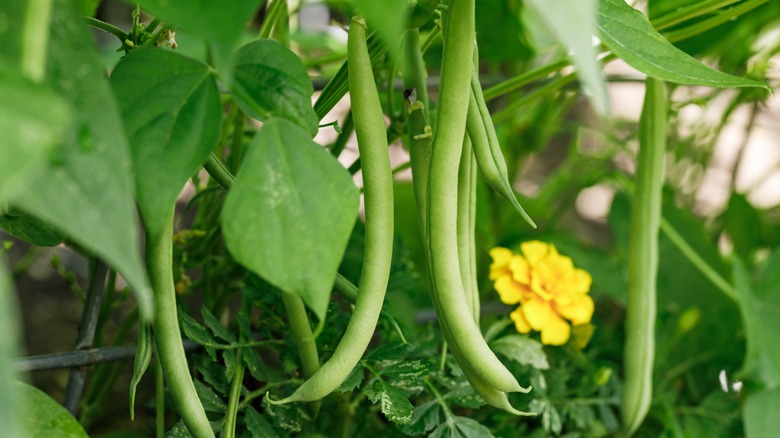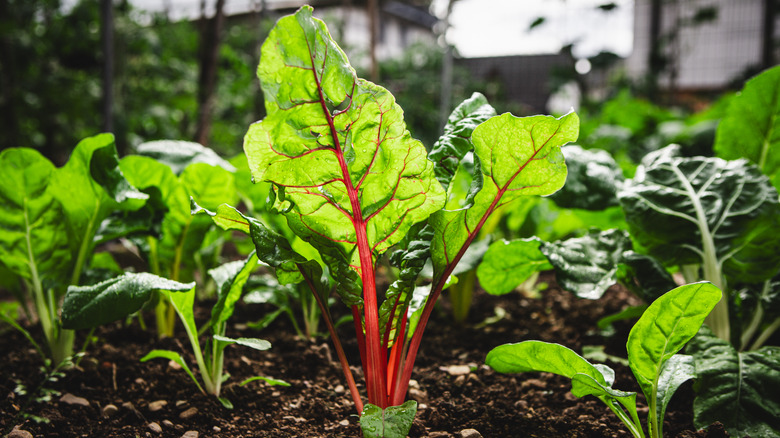Tasty, Cold-Hardy Vegetables To Plant In Your Garden In Spring
If you have a vegetable garden, spring is a time of anticipation for the coming season. If you have space and sufficient light to plant seeds indoors, you can grow warm-weather plants like tomatoes, and then harden off the seedlings gradually before planting outside. But there are many cold hardy vegetables that can be planted from seed outdoors in early spring, even before the last hard frost. Tasty vegetables you can plant in early spring include beans, lettuce, carrots, cabbage, potatoes, and kale.
There are a few basic guidelines for the timing of when to sow seeds in spring. "Direct sowing" refers to planting seeds right into the soil of your garden plot, raised beds, or containers. Legumes, herbs, and root vegetables like carrots and parsnips perform well being directly sown into the garden. Spinach and peas can be sown in March, as soon as the soil is soft enough to dig. Starting in mid-March you can plant seeds for radishes, dill, carrots, parsnips, beets, and cilantro. In April, the ground is warm enough to directly sow seeds for greens, brassicas, and fennel, and you can also plant potatoes and onions.
Keep an eye on the weather forecast to see if a late hard frost might occur in your area. If it does, hold off on planting until temperatures are above freezing, just to be on the safe side. These cold-hardy vegetables are your best bet if you'd like to get an early start on your garden.
Kale
Kale has become popular in recent years for its excellent nutritional value. Whether you like it whirled into smoothies, chopped into salads or sauteed as a side dish, kale is wonderfully versatile. It's easy to grow in containers or in the garden; plant it 4-5 weeks before the last frost to ensure a great kale harvest. There are four basic types: curly, dinosaur (with narrow, flat, pebbly leaves), Siberian, and Red Russian. Recommended cultivars include 'Scotch Blue' (fast-growing, tender, curly), 'Red Ursa' (tender, sweet Red Russian, slow to bolt), 'Dazzling Blue' (gorgeous blue, cold hardy dinosaur), 'Lacinato' (flavorful, dark green heirloom dinosaur).
Radishes
Radishes grow quickly from seed and are a satisfying spring crop. Their crunchy texture and sharp, bright taste make them perfect for snacking or salads. They love cooler temperatures, and because they're small they can be easily grown in containers, or between rows of other root vegetables like beets or carrots. Once daytime temperatures consistently reach 70 degrees Fahrenheit it is common for radishes to start to bolt, so they're best grown in cool temperatures of early spring or early autumn. They grow best with at least six hours of sun per day in spring.
Peas
Fresh peas or young peapods harvested fresh from the garden are delicious. They grow quickly during spring's damp, cool days. The seeds can be planted as early as February, as soon as the ground has thawed and is workable. Having a small trellis or string supports for the pea vines to climb on is a good idea and makes them easier to harvest. Radishes and peas make good companion plants. Sweet peas, aka garden peas, are grown for their edible seeds (peas), while snow peas or snap peas are grown both for seeds and their tender peapods.
Carrots
Carrots are versatile, sweet root vegetables that can be eaten raw or cooked into soups, stews, or even baked goods. They can be directly sown in early spring in containers or in the ground. Carrots like loose, rich, very well-draining soil, and don't do well in clay or rocky soils. Carrot seeds are tiny, so growing them usually requires thinning the seedlings once they get about two inches high. There are four main types: Imperator (very long), Danvers (6-7 inches long), Nantes (smooth, dense, cylindrical), and Chantenay (short, rounded); they all have different growing habits and harvesting tips.
Cabbage
Cabbage is a very cold-hardy brassica that grows well in early spring. It can be planted through late spring but doesn't like hot weather. Because large cabbage varieties take time to put on size, they're somewhat vulnerable to pests like cabbage worms. Cabbage is also a heavy feeder and benefits from soil with aged manure and compost added before planting. Once harvested, cabbage heads keep very well for a few days at cool (not too cold) temperatures. The Old Farmer's Almanac suggests you rotate your planting location to help avoid pests and diseases in the soil.
Broccoli
Like cabbage, broccoli takes a while to reach maturity, and prefers cool temperatures. Many gardeners plant broccoli in mid-summer for an autumn harvest, but a heat-tolerant, fast-maturing variety (like 'Flash,' 'Green Magic' or 'Green Emperor') can be planted from seed in spring. Broccoli likes a sunny spot and rich soil. The immature plants have a strong scent and attract rodents that like to nibble them, so if rabbits or groundhogs are a problem in your garden, be sure to protect your broccoli plants. Water broccoli well and use organic mulch (leaves or shredded bark) to preserve moisture.
Potatoes
Commercial potatoes are often grown using chemical fertilizers and pesticides, so growing organic potatoes is a sustainable, rewarding venture. Plant seed potatoes in late March or as soon as the ground starts to warm up a bit. Potatoes like rich, well-draining, loamy soil. Add well-composted manure at least two weeks before planting. Potatoes also grow well in containers, especially if you enjoy "baby potatoes" harvested early (red, gold or blue potato varieties work well for this), or smaller varieties like fingerlings. Straw is a good mulch that deters weeds and potato beetles.
Lettuce
Lettuce is a fast-growing crop that is very suitable for containers. Lettuce also loves partial shade and cool temperatures, making it the perfect spring vegetable to grow from seed. Growing lettuce works best if it's planted in spring and/or early autumn, as hot weather causes it to bolt quickly. However, if you have to plant when it's warm, there are delicious heat-tolerant lettuces that are slower to bolt, especially loose leaf varieties like butterheads, and green leaf or red leaf lettuces. These heirloom cultivars are good heat-tolerant lettuces: 'Parris Island,' 'Rouge D'Hiver,' 'Marvel of Four Seasons,' and 'Little Gem.'
Beets
Beets are a nutrient powerhouse, from their earthy below-ground tubers to their delicious tender greens. Plant in early spring as soon as the soil is workable, or in late summer as temperatures start to cool down. Like peas, kale, and beans, beets prefer slightly alkaline soil, so if your soil is acidic, stir in a spoonful of baking soda before planting, and add some compost to improve richness and drainage. Some cultivars like 'Red Ace' make great "baby beets" harvested when small and tender. Soaking beet seeds before planting can improve germination.
Spinach
Freshly-harvested spinach adds flavor and nutrition to salads and is delicious when cooked. Growing spinach from seed is fairly easy in containers or the garden, and it tolerates light shade. It's very cold hardy and can be planted early in spring or early autumn (soil temperatures between 40 and 70 degrees Fahrenheit are best). For best germination, mix in compost a week before planting seeds. To grow spinach in summer, try more heat-tolerant varieties like New Zealand spinach or climbing Malabar spinach, and water regularly. The Old Farmer's Almanac recommends thinning seedlings when they get two inches tall.
Beans
The two types of beans planted in spring are bush beans and pole beans. Bush beans don't require support, but pole beans grow on long vines and need staking or trellis supports. Pole beans have a longer harvest period, but bush beans can be planted at intervals. Both can be planted after the last hard frost date. Keep an eye on the forecast, and avoid planting before long rainy periods, as beans won't germinate if the soil is too wet. The Old Farmer's Almanac recommends amending soil for beans with aged manure or compost in fall or early spring.
Swiss Chard
Swiss chard is a large-leafed tender green that is easy to grow. It likes well-drained soil and regular watering. The thick but tender stems range in color from white to red, depending on the variety. Swiss chard is very cold hardy and grows well in containers. It can be planted from seed in early spring, and again in late summer for an autumn harvest. Unlike spinach, Swiss chard is very slow to bolt. Try one of these varieties: 'Fordhook Giant' (large and vigorous), 'Oriole' (bright orange stems), or 'Peppermint' (pink and white stems).
